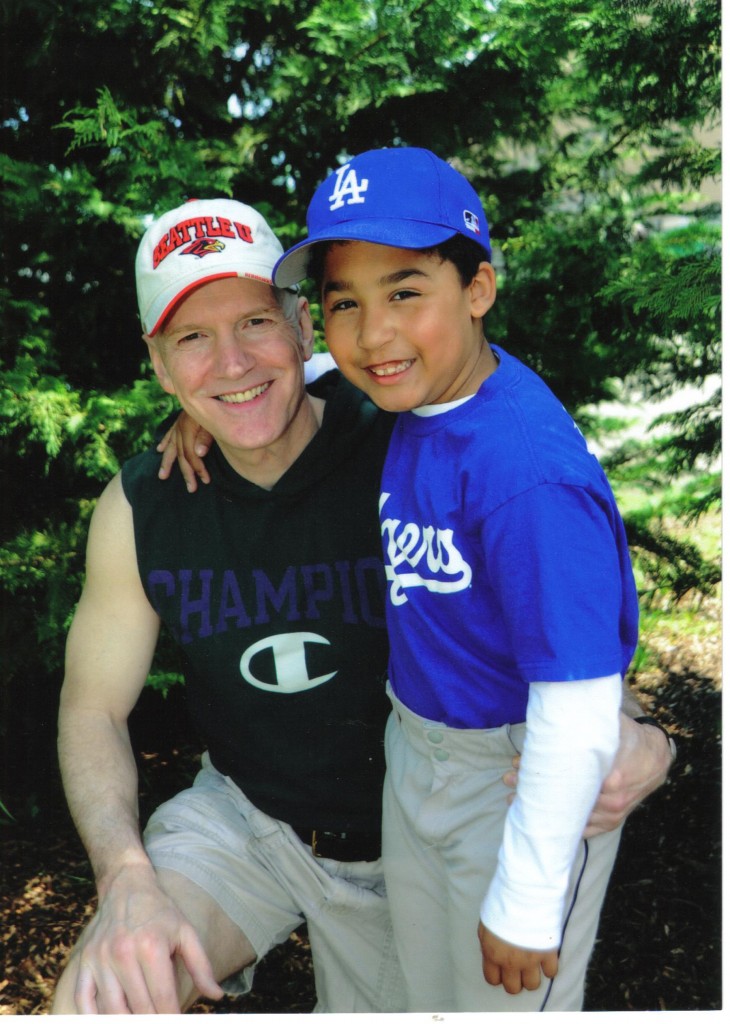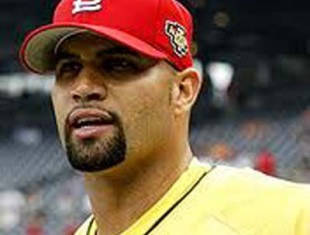Clay Moyle and son Caleb
I wasn’t sure if Raul Ibanez was going to be able to do it but he recently managed to tie Ted Williams’ mark of 29 home runs in a season for a ballplayer over age 40. I was really starting to wonder if he’d do it after his production slowed down so much after the July All-Star break.
Hopefully, he’ll manage to knock one more out the park so he’ll be able to claim sole ownership of the record.
In case you weren’t already aware of it I’ll point out the fact both men batted from the left side of the plate. Is it any coincidence the two men who have hit the most home runs in a single season after the age of 40 batted from that side of the plate? No, definitely not, it’s clearly an advantage to be a left-handed batter in the big leagues.
You see, it’s a well-known fact roughly 10 percent of the population is left-handed. As a result, the percentage of right-handed pitchers in major league baseball is much greater than those who are left-handed.
When you combine that with the fact a right-handed pitchers curve ball will break away from a right-handed batter and thus be more difficult to hit than it is for a left-handed batter. That same pitch will curve in toward the left-handed batter, which gives them an advantage over their right-handed counterparts whenever they face the majority of pitchers they will encounter in the big leagues.
Right-handed batters just don’t have as many opportunities to face left-handed pitching as left-handed batters do against right-handed pitching.
Wikipedia also pointed out left-handed batters also have another advantage as a result of a slightly shorter run from the batter’s box to first base, so there is a greater opportunity for them to beat throws to the bag on infield ground balls.
As a result, I found a statistic on Wikipedia that claimed left-handed batters have posted 16 of the top 20 career batting averages in major league history. Furthermore, out of the 25 men who have hit at least 500 career home runs, 10 were left-handed and two others were switch hitters.
Again, this is despite the fact a much greater percentage of all big league batters in history batted from the right side of the plate.
I came across a 2008 Newsweek magazine article that indicated while only 10 percent of the population was left-handed, southpaws made up 25 percent of all major league baseball players because of the distinct advantages that presented for them.
That same article also pointed out that most big league ballparks are built thinking of right-handed batters and as a result the left field fence is typically further away from the plate than the right field fence. So whenever a lefty comes to the plate he has a shorter distance to hit the ball out of the park than a righty does.
A quick look at the dimensions of Seattle’s Safeco stadium revealed this to be true of the Mariner’s home field, though it isn’t a dramatic difference. The distance from the plate to the wall down the left-field line is 331 feet this season in comparison to 326 feet down the right-field line.
Likewise, the left-center fence measures 390 feet from the plate while the deepest point of the right-center field fence is five feet shorter at 385. A quick comparison of Yankee Stadium field distances to the left and right field walls are very similar to what I found for Safeco.
Ok, so it’s pretty obvious that being left handed is a distinct advantage in major league baseball. What about other sports? Is it an advantage in other sports as well?
Well, in terms of basketball I know from personal experience that I rarely had to guard someone who was left-handed. I was much more accustomed to forcing a player to dribble with his left hand, the weaker hand. Whenever I found myself facing a left-handed offensive player I had to make sure I remembered to try and force them the opposite direction than I normally would, and it was much more likely that he may surprise me with a southpaw move I wasn’t accustomed to.
I’m old enough to remember when Hall-of-Famer Lenny Wilkens was a star point guard in the NBA. At the time, there were a number of great defensive players, including the New York Knicks Walt Frazier. He said that they always knew Wilkens was going to go left, but he always suckered them in and managed to go that way anyway.
I suspect that’s because many of us are so used to guys going right that even though we know a guy is left-handed once he starts going to the right our natural tendency is to try and stop them and they simply reverse direction to their strong hand.
Of course, they are also going to shoot with a hand right-handers are not used guarding against.
On the defensive end of the floor a southpaw’s strong arm is matched perfectly for blocking a right-hander’s shot. Is it a coincidence that the man many still consider the greatest defensive player and shot blocker ever, Bill Russell, was left-handed?
My own daughter is left-handed and for a number of years astounded me with how many shots she blocked in the local youth recreational basketball league despite the fact she was often matched up against taller players. I hadn’t thought of the fact she was left-handed could have been a contributing factor, but now I suspect it was.
What about left-handed boxers?
Well, they might enjoy a greater advantage over right-handed opponents than in any other sport. I recall a phone conversation I had years ago with a great Seattle middleweight champion from the 1930s named All Hostak in which the topic came up and he felt so strongly about the advantage that southpaws had in boxing he told me he thought they should be outlawed in the sport.
When two right-handed boxers face one another the angles of the opposition’s attack are relatively narrow and closed, per an excellent article on the subject I found on-line under the ExpertBoxing.com Website. So, when two equally skilled right-handers are matched against one another it’s fairly easy for them to cover up and make it a defensive battle.
But, when a right-handed boxer faces a southpaw the angles of attack are drastically altered because of the mirror stances of the fighters. The southpaw has all the advantage in that situation because he’s trained and practiced at using those angles against the vast majority of fighters who are right-handed.
The right-handed fighter will be more often surprised and hurt by the southpaw’s punches because they have typically faced very few left-handed fighters and they’re not as used to seeing the punches come from those angles.
Whenever a right-handed boxer faces a southpaw they encounter big left crosses coming from the side they are used to expecting weaker left jabs, and on the other side where they are used to watching out for less frequent big right hand punches they will find themselves facing faster right jabs. Of course, the same is true of left-handed boxers facing a right-hander, but again they’re much more accustomed and trained for that than a right-handed fighter is.
Undoubtedly, left-handers enjoy similar advantages in other sports such as tennis and fencing. The funny thing is there was a time long ago when being left-handed was considered such a big disadvantage in life that many parents would actually make every effort possible to convert their child into a right-hander as a toddler.
Maybe it is an inconvenience to be a southpaw in a right-hand dominated world. Think of all those desks that one would normally find in the classroom with the right-handed arm writing area.
But, make no mistake, being left handed is clearly an advantage in terms of many sports.
A right-handed desk, the bane of left-handed students



